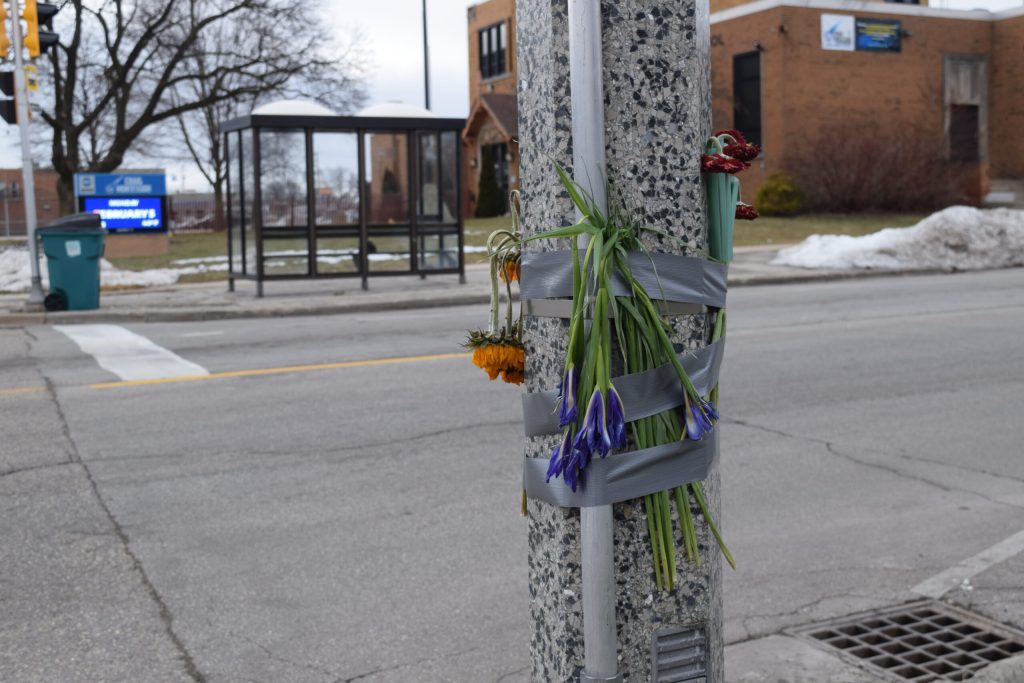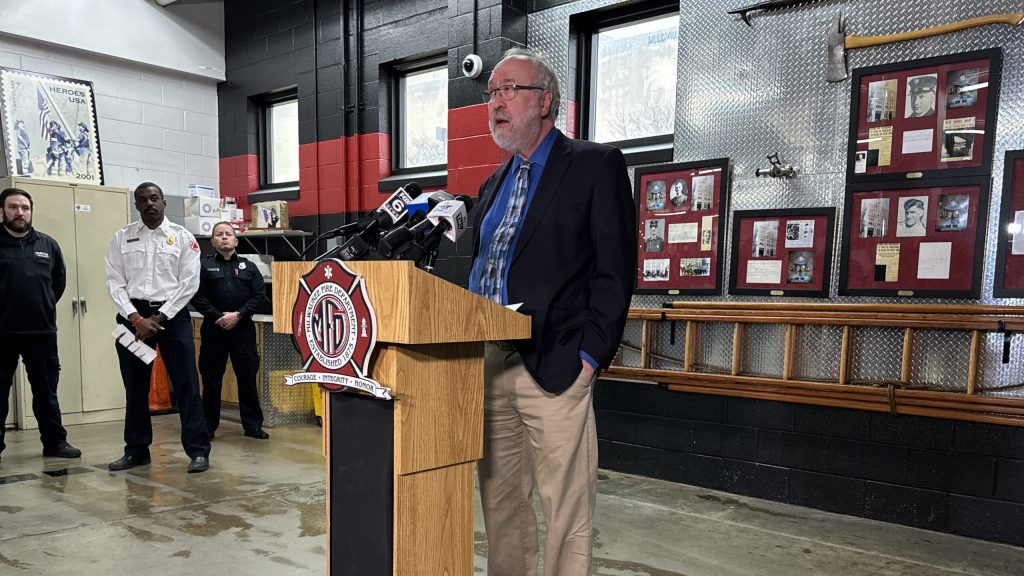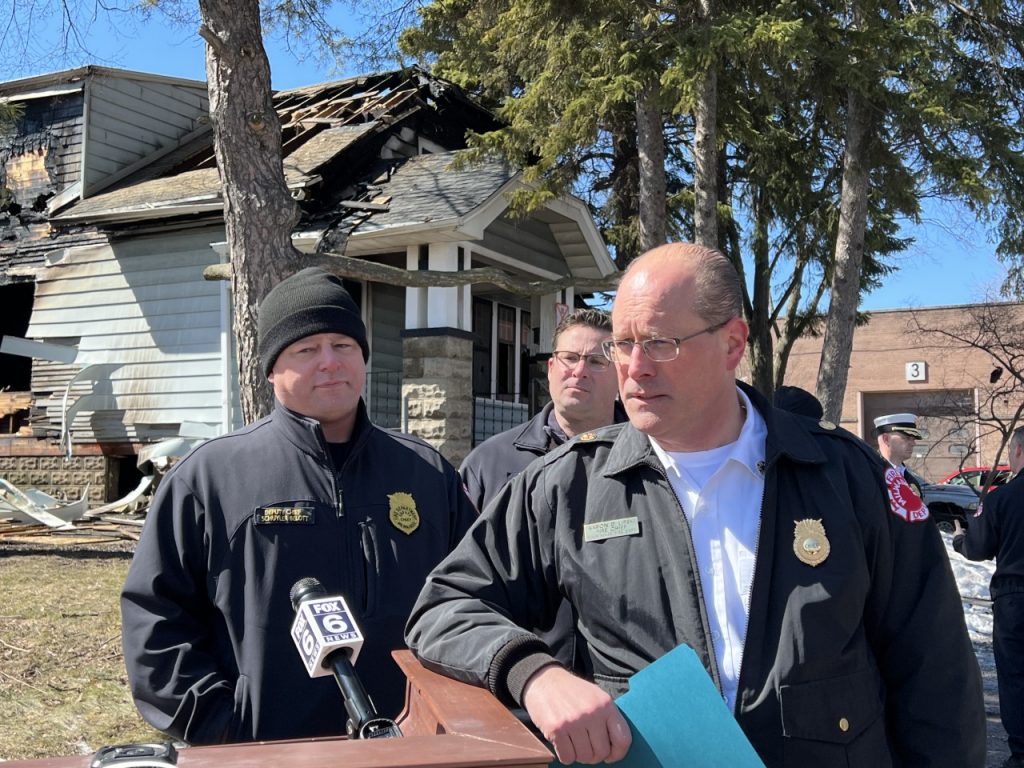Milwaukee Officials Urge Ambulance Policy Changes After Woman’s Death
Unanimous Common Council measure calls for future operating procedure updates.

Jolene Waldref died near this intersection on Milwaukee’s north side after she slipped and fell while wating for her bus. Evan Casey/WPR
Milwaukee officials are urging local ambulance companies and the Milwaukee Fire Department to change their policies in the wake of the January death of a 49-year-old woman in subzero temperatures.
Paramedics with Curtis Ambulance never stepped out of their vehicle to look for Jolene Waldref, who called 911 for help while waiting for a bus in subzero temperatures on the city’s north side. Her death is being investigated as probable hypothermia.
The Milwaukee Common Council unanimously passed a resolution Tuesday urging the fire department and private ambulance companies in the city to require paramedics to “exit their vehicles and search for those requesting assistance when weather, other environmental conditions, or obstructions, create impaired or reduced visibility at or around the location or landmark to which responders are dispatched.”
A spokesperson for Milwaukee Mayor Cavalier Johnson said the mayor supports the resolution and plans to sign it.
The common council also voted to delay discussing new contracts for Curtis Ambulance and Bell Ambulance — the city’s two private ambulance companies — until a later date. Meanwhile, the Milwaukee Fire Department will meet with those companies on Wednesday to discuss possible changes in the wake of Waldref’s death.
Milwaukee Alder Lamont Westmoreland hopes delaying the contracts will put pressure on the companies. He said it’s a way to “hold their feet to the fire” regarding policy changes the council wants to see.
“This is an opportunity for us to hold this, have further discussion and hopefully, they’ll make the right decision and improve their policy,” Westmoreland said during the council meeting Tuesday.
Curtis Ambulance CEO James Baker did not return a WPR reporter’s phone calls, but he told the Milwaukee Journal Sentinel he’s open to discussing changes. Baker also said he’d be open to foot search requirements in some scenarios, but he said that’s “a very subjective thing,” according to a WISN-12 report.

Curtis Ambulance CEO James Baker takes questions from the media on Tuesday, Jan. 30, 2024. Evan Casey/WPR
Bell Ambulance Director of Operations Chris Anderson, who is also the president of the Professional Ambulance Association of Wisconsin, said he’s open to discussing changes for his company.
“If we can get a positive out of this and it allows us to make a better system, then I think it’s a plus,” Anderson said.
Anderson said there’s currently no policy at Bell Ambulance that requires paramedics to get out of their vehicles to look for a patient when responding to a call. But he did say they must make “every reasonable effort” to find the patient and must document what efforts were made.
“No matter what we do, I think we ultimately have to leave some discretion up to the responders that arrive on scene, just because every situation is so different,” Anderson said.
‘You would think it wouldn’t just be a roll through’
During a Jan. 30 news conference, Baker said his paramedics responding to Waldref’s 911 call were unable to locate her after driving through the intersection twice. They also attempted to call Waldref but left when she didn’t answer her phone.
About 20 minutes later, bystanders called 911 again after finding Waldref unconscious behind snow banks at the intersection. They stayed with her until paramedics with the Milwaukee Fire Department arrived at 5:52 p.m. following the second call.
On a 911 call, Waldref can be heard saying “I cannot breathe” when dispatchers asked her why she called 911. When she was asked what happened, she responded by saying “I don’t know.”
Medical calls to Milwaukee’s 911 system are split between the the fire department’s paramedics and Bell and Curtis. Dispatchers triage calls and send ambulance crews based on the caller information. Bell and Curtis respond to low priority calls in the city, which can include basic life support calls like broken bones and cuts.
Laura Albert, an industrial and systems engineering professor at the University of Wisconsin-Madison, said although the initial response time of four minutes was quick, she questioned why it was labeled a low priority call.
“Maybe some information wasn’t really conveyed clearly along the way,” Albert said.
Albert also said it’s common for people not to be found when they call 911, mainly because they leave before an ambulance gets to them. Baker also said false alarms are common, especially at bus stops. He said callers sometimes call for an ambulance at a bus stop and get on a bus if it arrives before the ambulance does.
But that response wasn’t good enough for Alder Westmoreland. He said the extreme cold and the high snow piles should have been all the more reason for the paramedics to get out and keep looking.
“You would think it wouldn’t just be a roll through,” Westmoreland said in an interview with WPR.
“They’ve got to get out the vehicle and look,” he added.
The resolution passed Tuesday also urges Milwaukee Fire Chief Aaron Lipski to “conduct an analysis of existing and future technological capabilities to improve the potential for responders to locate cellular telephone 911 callers.” It urges Lipski to review existing 911 dispatch protocols and to enhance responses for patients who are outdoors in extreme weather conditions.
“That means that those service providers are unavailable for other patients that might need that lifesaving care really quickly,” she said.
Alder Mark Borkowski, the chair of the city’s ambulance services board, said he thinks a change is necessary.
“There will be change, and regardless of what is said publicly, I don’t believe, in my mind’s eye, that a situation like this will ever happen again, whether they put it in writing or not,” Borkowski said during the council meeting Tuesday.
Waldref — whom her former neighbor described as a positive person who would go out of her way to help others — leaves behind two daughters, ages 14 and 21.
Milwaukee officials urge ambulance policy changes following woman’s death was originally published by Wisconsin Public Radio.
Political Contributions Tracker
Displaying political contributions between people mentioned in this story. Learn more.






















